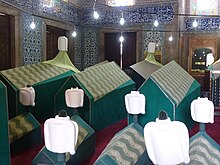| Fatma Sultan | |||||
|---|---|---|---|---|---|
 | |||||
| Born | c. 1606/1607 Topkapı Palace, Constantinople, Ottoman Empire (present day Istanbul, Turkey) | ||||
| Died | 1670 (aged 63–64) Istanbul, Ottoman Empire | ||||
| Burial | Sultan Ahmed Mosque, Istanbul | ||||
| Spouses |
Çatalcalı Hasan Pasha
(m. 1629; died 1631)Canbuladzade Mustafa Pasha
(m. 1632; executed 1636)Koca Yusuf Pasha
(m. 1637; died 1658)Kanbur Mustafa Pasha
(m. 1663; died 1666)Közbekçi Yusuf Pasha
(m. 1667) | ||||
| Issue | second marriage Sultanzade Hasan Bey third marriage Sultanzade Hüseyin Pasha Sultanzade Süleyman Bey | ||||
| |||||
| Dynasty | Ottoman | ||||
| Father | Ahmed I | ||||
| Mother | Kösem Sultan | ||||
| Religion | Sunni Islam | ||||
Fatma Sultan (Ottoman Turkish: فاطمه سلطان, "one who abstains"; 1606/1607,[2] Topkapi Palace, Constantinople, – 1670,[3]: 168 ) Constantinople) was an Ottoman princess. She was the daughter of Sultan Ahmed I (r. 1603–1617) and Kösem Sultan,[4][5] sister of Murad IV (r. 1623–1640) and Ibrahim (r. 1640–1648), and the paternal aunt of Mehmed IV (r. 1648–1687). She is known for her many political marriages.
- ^ Uluçay 1992, p. 50.
- ^ Peirce 1993, p. 246.
- ^ Miović, Vesna (2018-05-02). "Per favore della Soltana: moćne osmanske žene i dubrovački diplomati". Anali Zavoda Za Povijesne Znanosti Hrvatske Akademije Znanosti i Umjetnosti U Dubrovniku (in Croatian). 56 (56/1): 147–197. doi:10.21857/mwo1vczp2y. ISSN 1330-0598.
- ^ Singh, Nagendra Kr (2000). International encyclopaedia of Islamic dynasties (reproduction of the article by M. Cavid Baysun "Kösem Walide or Kösem Sultan" in The Encyclopaedia of Islam vol V). Anmol Publications PVT. pp. 423–424. ISBN 81-261-0403-1.
Through her beauty and intelligence, Kösem Walide was especially attractive to Ahmed I, and drew ahead of more senior wives in the palace. She bore the sultan four sons – Murad, Süleyman, Ibrahim and Kasim – and three daughters – 'Ayşe, Fatma and Djawharkhan. These daughters she subsequently used to consolidate her political influence by strategic marriages to different viziers.
- ^ Peirce, Leslie P. (1993), The Imperial Harem: Women and Sovereignty in the Ottoman Empire, Oxford University Press, p. 365, ISBN 0195086775